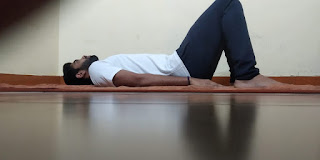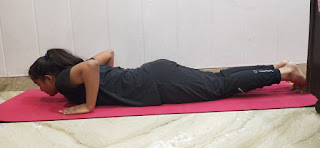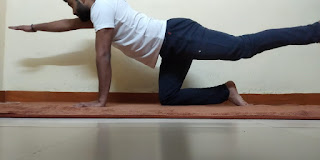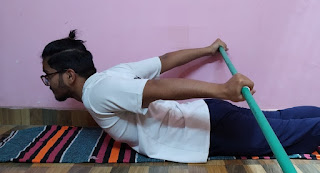We all at some point in our life have experienced mild back
pain. For some it is acute and for some it became chronic. This article won’t
be a one-time read article, someone in your family, your relatives, or your friend
might need it. I request you to do a visit, again and again, this page for the
information according to your needs.
In this article, you will get some stretching and strengthening exercises that will help you in treating your back pain. There are many reasons which can cause back pain i.e. Osteoporosis, Arthritis, Sciatica, Bulging disks, Strain, Sprain. Another reason can be your sitting habit or bad postural habits and bad movements such as:
In this article, you will get some stretching and strengthening exercises that will help you in treating your back pain. There are many reasons which can cause back pain i.e. Osteoporosis, Arthritis, Sciatica, Bulging disks, Strain, Sprain. Another reason can be your sitting habit or bad postural habits and bad movements such as:
- Bending forward for a longer period
- Wrong pushing and pulling movements
- Twisting
- Lifting heavyweights
Generally, the problem in the neck and upper back are strain and sprain. Whereas, the pain in the lower back is related to compression fracture and herniated discs. We will discuss some of the mobility and strengthening exercises which are commonly and extensively used in physiotherapy or exercise therapy for treating back pain.
LUMBAR
REGION
- Glutes Bridge
This exercise also includes various bodyweight workouts. But a few know about its benefits for lower
back or lumbar region.
1. Lie flat on a
surface (better if slightly padded) bending your knees.
2. Hand flat and
outside your body
3. Push through your
heels, squeeze your butts, and raise your lower body while placing shoulder blades
down.
4. Hold this position
for 3-5 seconds.
5. Slowly bring your
body down to the initial position.
- Lying back extension or Cobra pose
1. Lie in a prone
position. Place hands at sides at chest level.
2. Push from your palms and lift your body upward, while keeping your waist down. Many people
lift the whole pelvic region to stop that and also for adding resistance you
can take aboard and tie a belt or cloth and tie your waist. Hold for 3-5 seconds.
One of the most effective exercise
which I have personally come across and recommends to everyone.
1. Bent down with
feet apart and palms positioning down at shoulder width.
2. Stretch your belly
downward and heads gazing up to the ceiling. Hold for 1 sec. (Cow pose)
3. Slowly pull your
head downward and stretch your spine upward. Hold for 1 sec. (Cat Pose)
- Alternate leg and hand raise
One of the best mobility and
strengthening exercise for the lower back.
1. Bent down with
feet apart and palms positioning down at shoulder width.
2. Raise your right hand
with the left leg while maintaining your posture and balance. Try to position your arms,
shoulder, and pelvis in a straight line. For beginners, it can be difficult. Maintain
the position for 2-3 seconds
3. Come back to the
initial position and repeat it with the other hand and leg. Maintain it for 2-3 seconds.
- Reverse V or Superman
Reverse V or superman is a
strengthening exercise specifically targeting the lower back. I put it in a little
bit intermediate and advance category as it is hard to maintain this posture.
Stop the exercise if you feel any pain.
1. Lie facing downward
(in prone position). Hand extending in front of you.
2. Slowly raise your
hands, shoulder, and legs simultaneously. Hold the position for 3-5 seconds.
3. Slowly get back
to the initial position and not like a potato bag.
THORACIC REGION
Ø Thoracic Extension movements
All these thoracic extensor exercises work effectively in people with kyphosis. It is also a great
exercise for that whose job makes her/him sit and work on computers for
longer periods. It can also help in treating shoulder forward rotation which is
caused by faulty sitting posture.
1.
Lie facing
down(prone). Hands sides. Grab a stick or towel behind the back.
2.
Slowly raise your
chest and towel or stick behind the back. While looking at the floor. Hold the
position for 2-3 seconds.
Ø Shoulder raises
1.
Lie down in prone
position. Grab a gym ball/weight while extending your arms in front of you.
2.
Slowly raise your
arms and shoulder as much as possible. Hold it for 3-5 seconds.
3.
Slowly get back
to the initial position.
Ø Thoracic raises
1.
Lie in supine
position hands in the sides. Bend your knees. It will be your starting position.
2.
Slowly raise your
hands backward while keeping elbow to the ground. Lift your chest up. Hold it
for 3-5 seconds.
The general recommendation for
performing these mobilities and strengthening exercises will be 5*5 (5 Sets of 5
repetitions). These exercises are not recommended for post-surgery. If your pain
persists do consult a physio or a doctor. STOP THE EXERCISE IMMEDIATELY IF YOU
FEEL PAIN.
BONUS: Many people experience lower back while sitting on a chair and during long drives. To counter it, scientists
and physiotherapists recommend using a lumbar support roll or pillow. One thing which needs to be considered and why lower back pain should be treated is that the lower back and pelvis act as the base of the body hindering their normal function leads to change in Gate patterns and also can lead to uneven patterns of walking. For more information on knee pain, you can click here
According to research published in the Journal of Chiropractic and Manual Therapies suggests that a lumbar support pillow or cut out helps healthy individuals and patients with low back pain issues by decreasing the lumbar flattening and increasing the thoracolumbar curvature which is directly related to back pain. You can use it in the office and driving.
According to research published in the Journal of Chiropractic and Manual Therapies suggests that a lumbar support pillow or cut out helps healthy individuals and patients with low back pain issues by decreasing the lumbar flattening and increasing the thoracolumbar curvature which is directly related to back pain. You can use it in the office and driving.
You should take a pause of 15 minutes after every
1 hour of continuous driving. Walk around 50m or for 2-3 minutes. Do some back
extensions. HOPE YOU ALL WILL HAVE A HEALTHY SPINE.
REFERENCES
Mackenzie, 7 steps to pain-free life, 2000.
















Bhai ye kuch yoga jaisa lagta hai thoda bahut mene bhi sikha tha
ReplyDeleteyes, abhishek many stretches and exercises are gifts from yoga.
ReplyDeleteGood work brijesh.
ReplyDeleteThank you for your kind words
DeleteIt's totally doable and relatable
ReplyDeletethank you charak kumar
DeleteFine info and rightly presented
ReplyDeleteThank you.
DeleteVery Good Brijesh
ReplyDeleteThank you for the info 👍
ReplyDelete